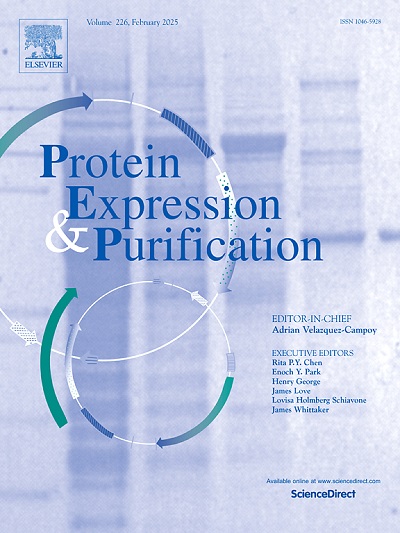Bacterial expression, purification and characterization of the human Dectin-1 lectin domain for structural and functional studies
IF 1.2
4区 生物学
Q4 BIOCHEMICAL RESEARCH METHODS
引用次数: 0
Abstract
Dectin-1 (CLEC7A), a C-type lectin-like receptor that recognizes β-1,3 glucans, has a key role in the innate immune system. While the lectin domain of mouse Dectin-1 has been solubilized and refolded from inclusion bodies in Escherichia coli, similar refolding of the human Dectin-1 lectin domain is hindered by the formation of misfolded multimers with aberrant intermolecular disulfide bonds. The aim of this study was to develop a method for the large-scale production of the human Dectin-1 lectin domain. Based on a protocol for the murine domain, the human Dectin-1 lectin domain was expressed as a fusion protein with Protein G B1, a solubility-enhancing tag. The refolding and purification conditions were then optimized by testing a range of buffers with and without Ca2+ ions. The inclusion of 1 mM Ca2+ ions in both the refolding and purification buffers resulted in high yields of a monomeric form of the human Dectin-1 lectin. The resulting recombinant protein was demonstrated to be functional, showing specific binding to the β-glucan laminarin as verified by thermal shift assays, gel filtration chromatography and NMR. Furthermore, NMR experiments revealed that the human Dectin-1 lectin domain binds Ca2+ ions. The recombinant protein will support structural biology studies to clarify differences in β-glucan binding specificity between human and mouse Dectin-1, and to explore the effects of mutations on the functionality of human Dectin-1.
人Dectin-1凝集素结构域的细菌表达、纯化和特性研究。
Dectin-1 (CLEC7A)是一种c型凝集素样受体,可识别β-1,3葡聚糖,在先天免疫系统中起关键作用。虽然小鼠Dectin-1的凝集素结构域在大肠杆菌中被溶解并从内含体中重新折叠,但人类Dectin-1凝集素结构域的类似重新折叠受到具有异常分子间二硫键的错误折叠多聚体的形成的阻碍。本研究的目的是开发一种大规模生产人Dectin-1凝集素结构域的方法。基于小鼠结构域的协议,人类Dectin-1凝集素结构域作为融合蛋白与蛋白G B1(一种可溶性增强标签)表达。然后通过测试一系列含有和不含Ca2+离子的缓冲液来优化再折叠和纯化条件。在重折叠和纯化缓冲液中包含1mm的Ca2+离子导致了人Dectin-1凝集素单体的高产率。通过热移分析、凝胶过滤层析和核磁共振证实,重组蛋白具有功能性,与β-葡聚糖层粘连蛋白特异性结合。此外,核磁共振实验表明,人Dectin-1凝集素结构域与Ca2+离子结合。重组蛋白将支持结构生物学研究,以阐明人和小鼠Dectin-1之间β-葡聚糖结合特异性的差异,并探索突变对人Dectin-1功能的影响。
本文章由计算机程序翻译,如有差异,请以英文原文为准。
求助全文
约1分钟内获得全文
求助全文
来源期刊

Protein expression and purification
生物-生化研究方法
CiteScore
3.70
自引率
6.20%
发文量
120
审稿时长
32 days
期刊介绍:
Protein Expression and Purification is an international journal providing a forum for the dissemination of new information on protein expression, extraction, purification, characterization, and/or applications using conventional biochemical and/or modern molecular biological approaches and methods, which are of broad interest to the field. The journal does not typically publish repetitive examples of protein expression and purification involving standard, well-established, methods. However, exceptions might include studies on important and/or difficult to express and/or purify proteins and/or studies that include extensive protein characterization, which provide new, previously unpublished information.
 求助内容:
求助内容: 应助结果提醒方式:
应助结果提醒方式:


